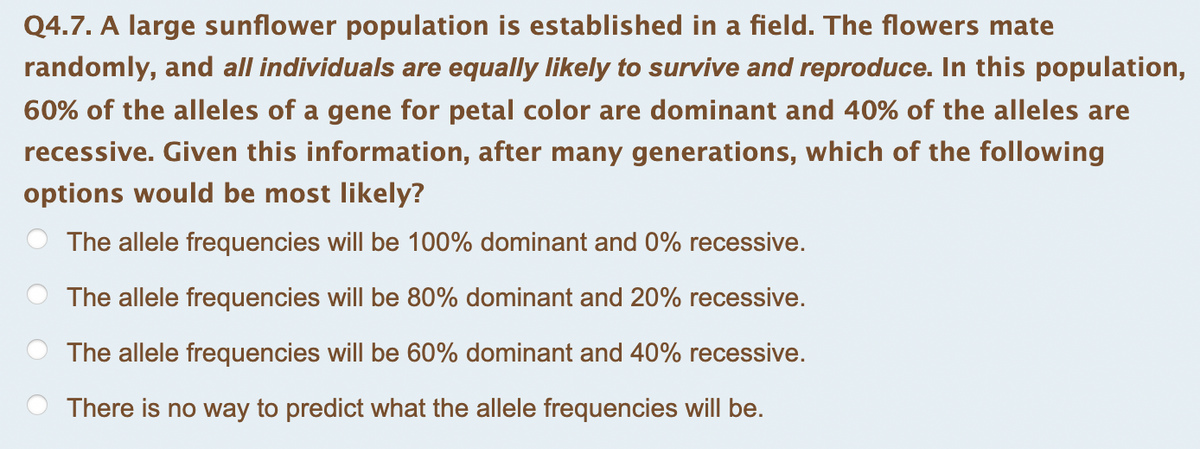Q4.7. A large sunflower population is established in a field. The flowers mate randomly, and all individuals are equally likely to survive and reproduce. In this population, 60% of the alleles of a gene for petal color are dominant and 40% of the alleles are recessive. Given this information, after many generations, which of the following options would be most likely? The allele frequencies will be 100% dominant and 0% recessive. The allele frequencies will be 80% dominant and 20% recessive. The allele frequencies will be 60% dominant and 40% recessive. There is no way to predict what the allele frequencies will be.
Q4.7. A large sunflower population is established in a field. The flowers mate randomly, and all individuals are equally likely to survive and reproduce. In this population, 60% of the alleles of a gene for petal color are dominant and 40% of the alleles are recessive. Given this information, after many generations, which of the following options would be most likely? The allele frequencies will be 100% dominant and 0% recessive. The allele frequencies will be 80% dominant and 20% recessive. The allele frequencies will be 60% dominant and 40% recessive. There is no way to predict what the allele frequencies will be.
Biology: The Dynamic Science (MindTap Course List)
4th Edition
ISBN:9781305389892
Author:Peter J. Russell, Paul E. Hertz, Beverly McMillan
Publisher:Peter J. Russell, Paul E. Hertz, Beverly McMillan
Chapter54: Ecosystems And Global Change
Section: Chapter Questions
Problem 16TYK
Related questions
Question

Transcribed Image Text:Q4.7. A large sunflower population is established in a field. The flowers mate
randomly, and all individuals are equally likely to survive and reproduce. In this population,
60% of the alleles of a gene for petal color are dominant and 40% of the alleles are
recessive. Given this information, after many generations, which of the following
options would be most likely?
The allele frequencies will be 100% dominant and 0% recessive.
The allele frequencies will be 80% dominant and 20% recessive.
The allele frequencies will be 60% dominant and 40% recessive.
There is no way to predict what the allele frequencies will be.
Expert Solution
This question has been solved!
Explore an expertly crafted, step-by-step solution for a thorough understanding of key concepts.
This is a popular solution!
Trending now
This is a popular solution!
Step by step
Solved in 4 steps

Knowledge Booster
Learn more about
Need a deep-dive on the concept behind this application? Look no further. Learn more about this topic, biology and related others by exploring similar questions and additional content below.Recommended textbooks for you

Biology: The Dynamic Science (MindTap Course List)
Biology
ISBN:
9781305389892
Author:
Peter J. Russell, Paul E. Hertz, Beverly McMillan
Publisher:
Cengage Learning

Biology 2e
Biology
ISBN:
9781947172517
Author:
Matthew Douglas, Jung Choi, Mary Ann Clark
Publisher:
OpenStax

Concepts of Biology
Biology
ISBN:
9781938168116
Author:
Samantha Fowler, Rebecca Roush, James Wise
Publisher:
OpenStax College

Biology: The Dynamic Science (MindTap Course List)
Biology
ISBN:
9781305389892
Author:
Peter J. Russell, Paul E. Hertz, Beverly McMillan
Publisher:
Cengage Learning

Biology 2e
Biology
ISBN:
9781947172517
Author:
Matthew Douglas, Jung Choi, Mary Ann Clark
Publisher:
OpenStax

Concepts of Biology
Biology
ISBN:
9781938168116
Author:
Samantha Fowler, Rebecca Roush, James Wise
Publisher:
OpenStax College